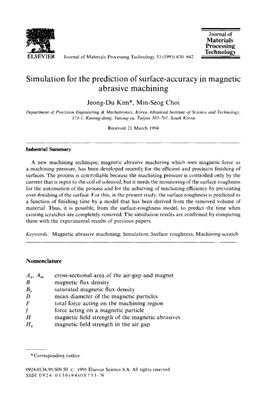Статья. Опубликована в журнале Joual of Materials Processing
Technology. – 1995. – Vol. 53 – P. 630-
642. На английском языке. Название на русском языке: Моделирование с целью предсказания точности поверхности при магнитно-абразивной обработке. Аннотация к статье на английском языке:
A new machining technique, magnetic abrasive machining which uses magnetic force as a machining pressure, has been developed recently for the efficient and precision finishing of surfaces. The process is controllable because the machining pressure is controlled only by the current that is input to the coil of solenoid, but it needs the monitoring of the surface roughness for the automation of the process and for the achieving of machining efficiency by preventing over-finishing of the surface. For this, in the present study, the surface roughness is predicted as a function of finishing time by a model that has been derived from the removed volume of material. Thus, it is possible, from the surface-roughness model, to predict the time when existing scratches are completely removed. The simulation results are confirmed by comparing them with the experimental results of previous papers.
642. На английском языке. Название на русском языке: Моделирование с целью предсказания точности поверхности при магнитно-абразивной обработке. Аннотация к статье на английском языке:
A new machining technique, magnetic abrasive machining which uses magnetic force as a machining pressure, has been developed recently for the efficient and precision finishing of surfaces. The process is controllable because the machining pressure is controlled only by the current that is input to the coil of solenoid, but it needs the monitoring of the surface roughness for the automation of the process and for the achieving of machining efficiency by preventing over-finishing of the surface. For this, in the present study, the surface roughness is predicted as a function of finishing time by a model that has been derived from the removed volume of material. Thus, it is possible, from the surface-roughness model, to predict the time when existing scratches are completely removed. The simulation results are confirmed by comparing them with the experimental results of previous papers.

